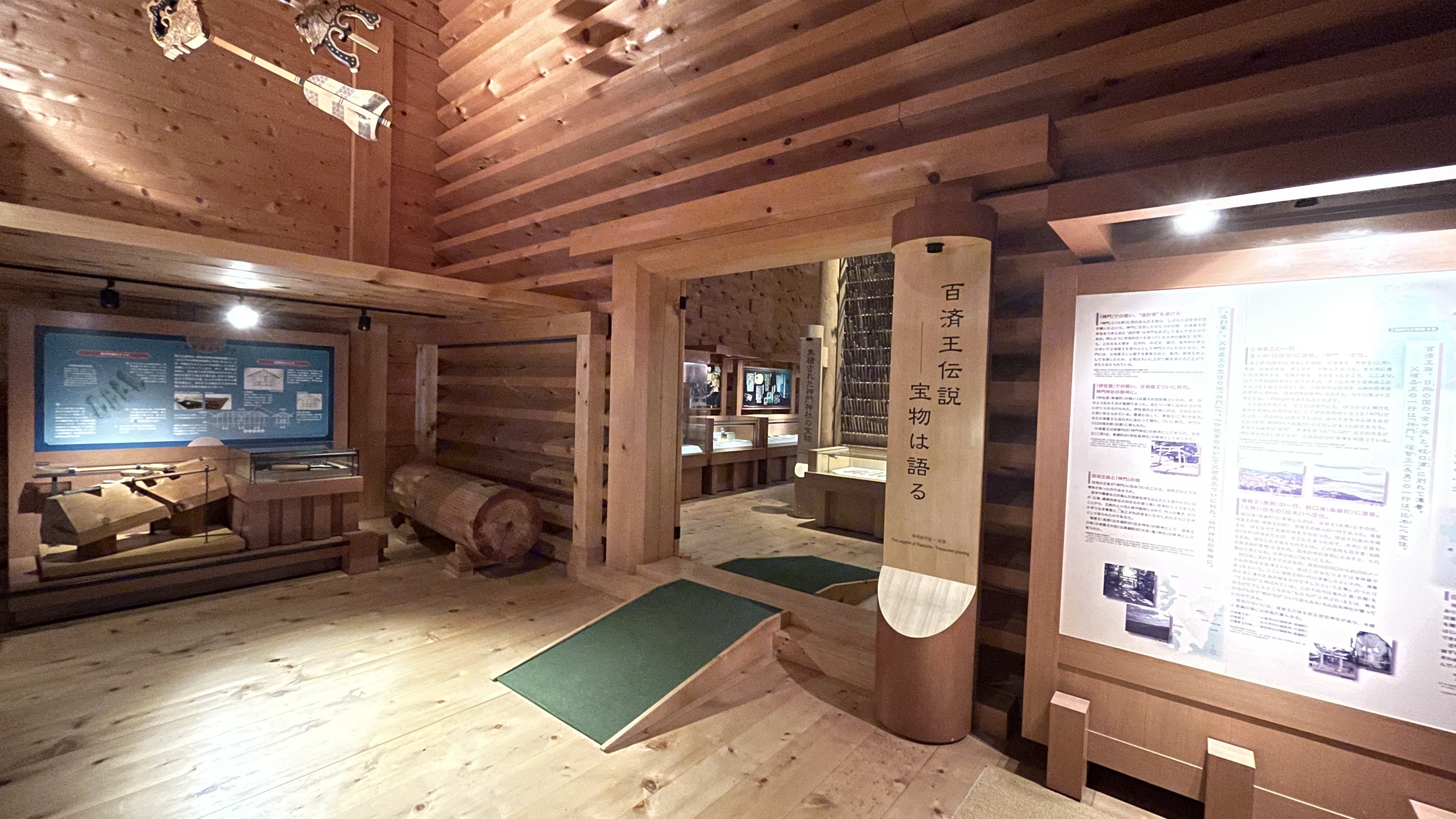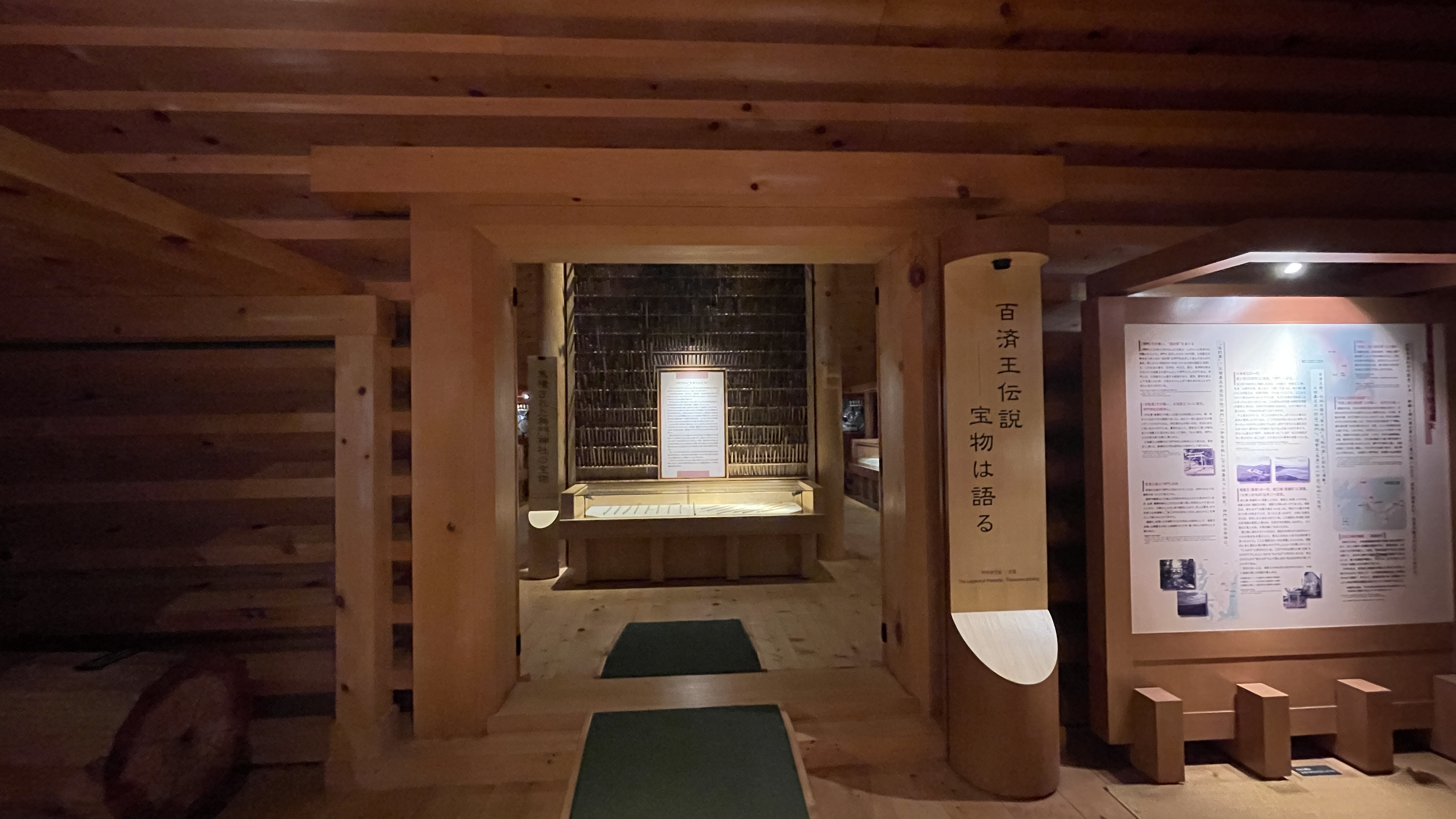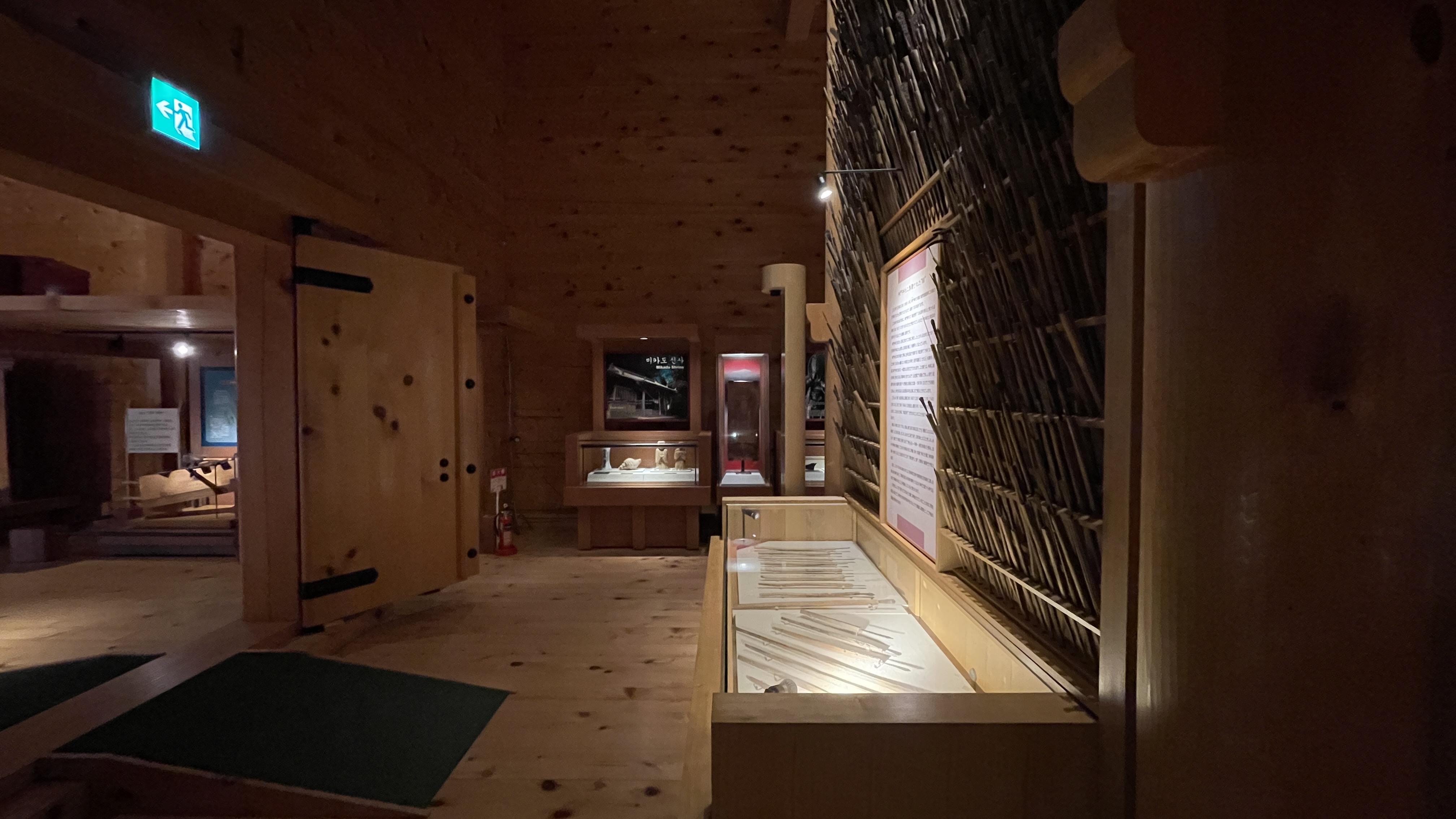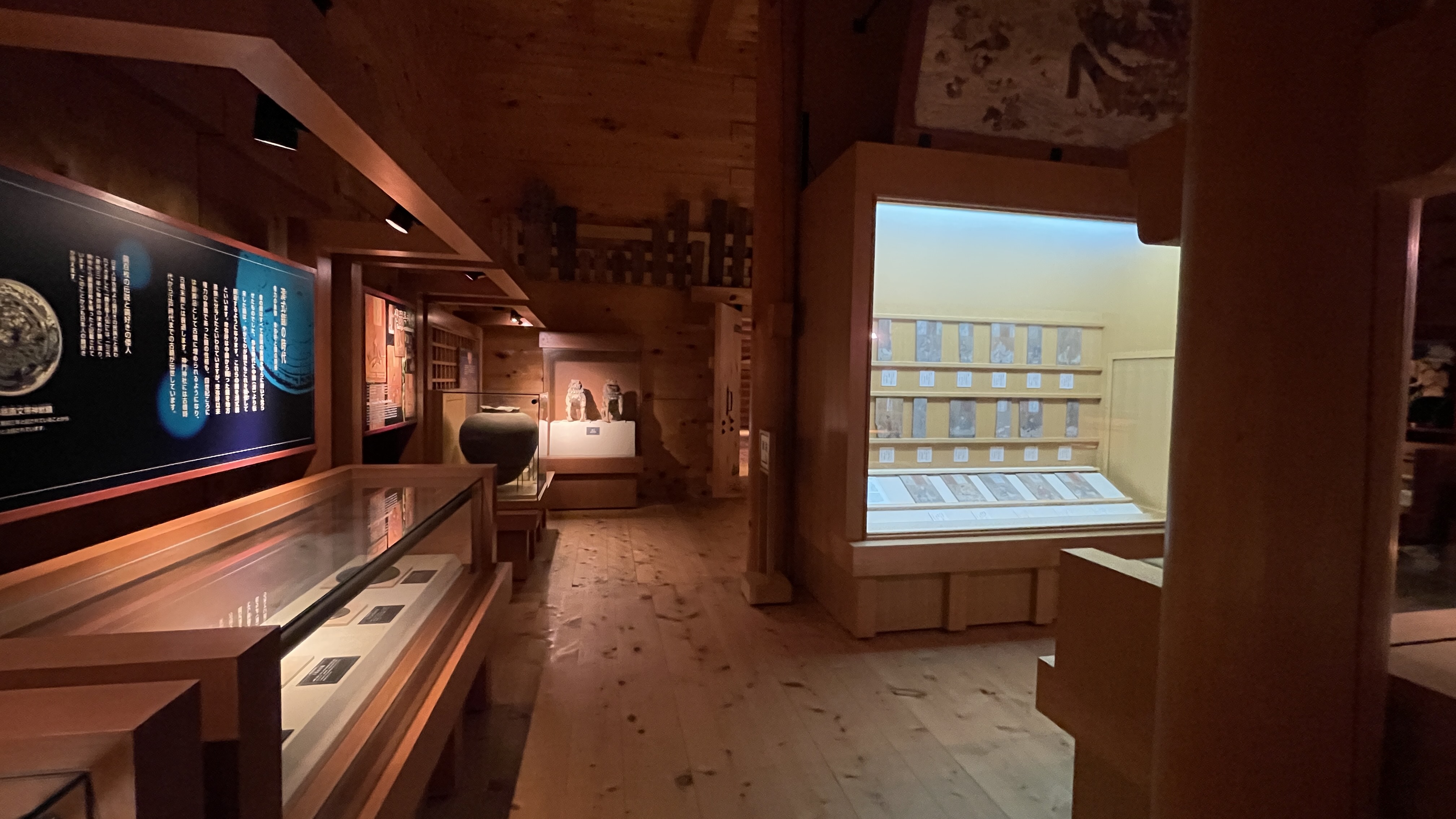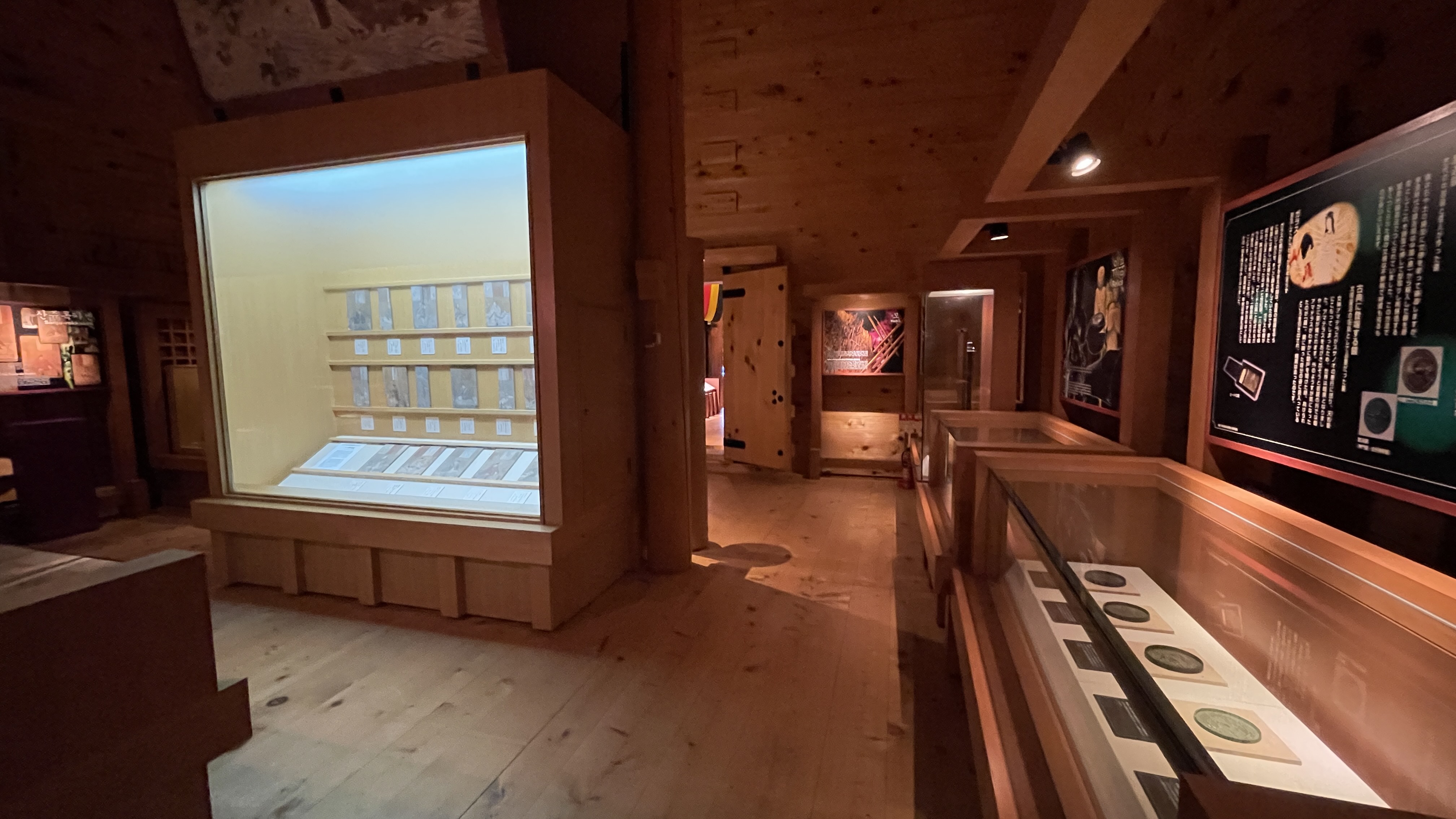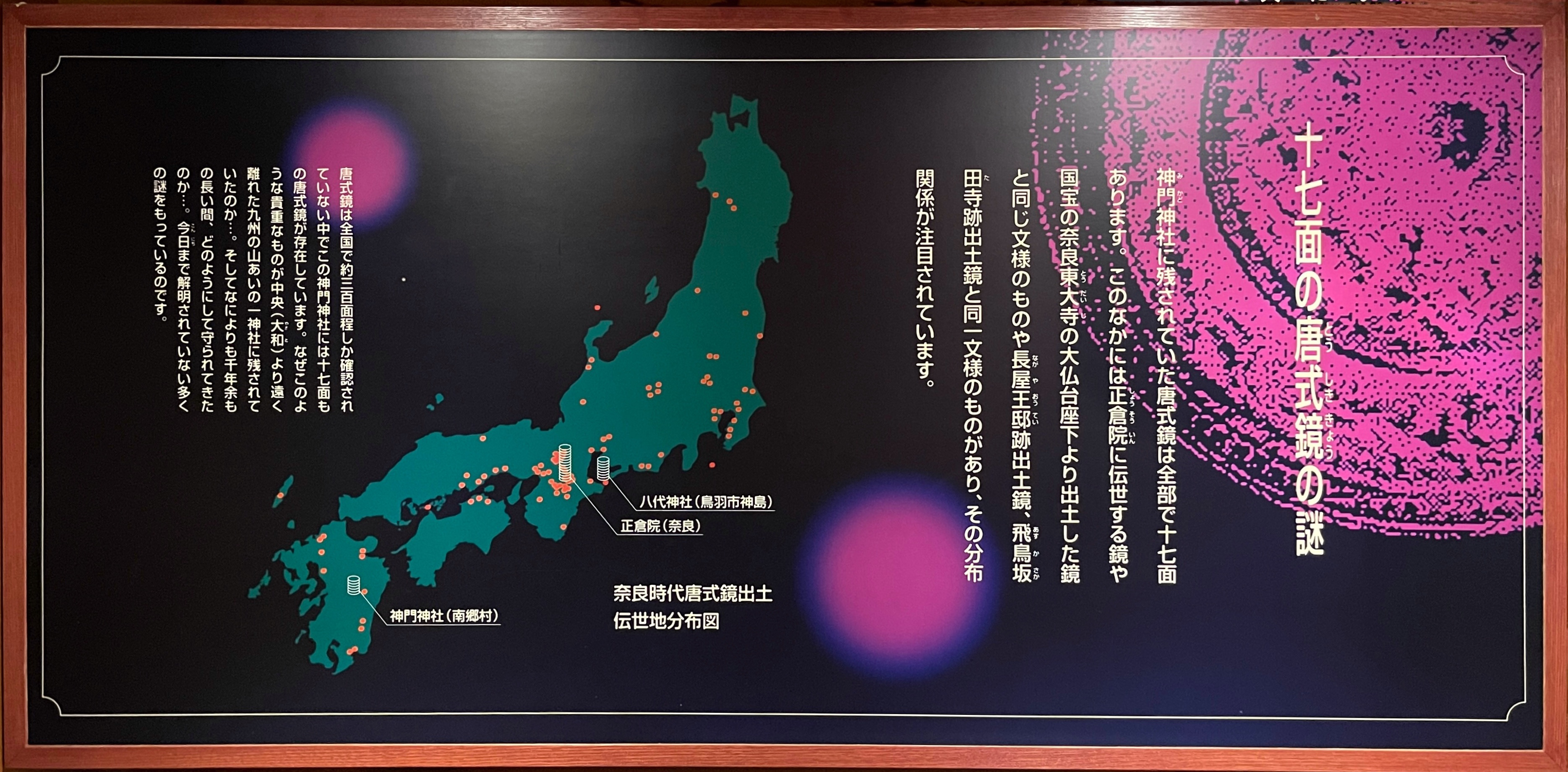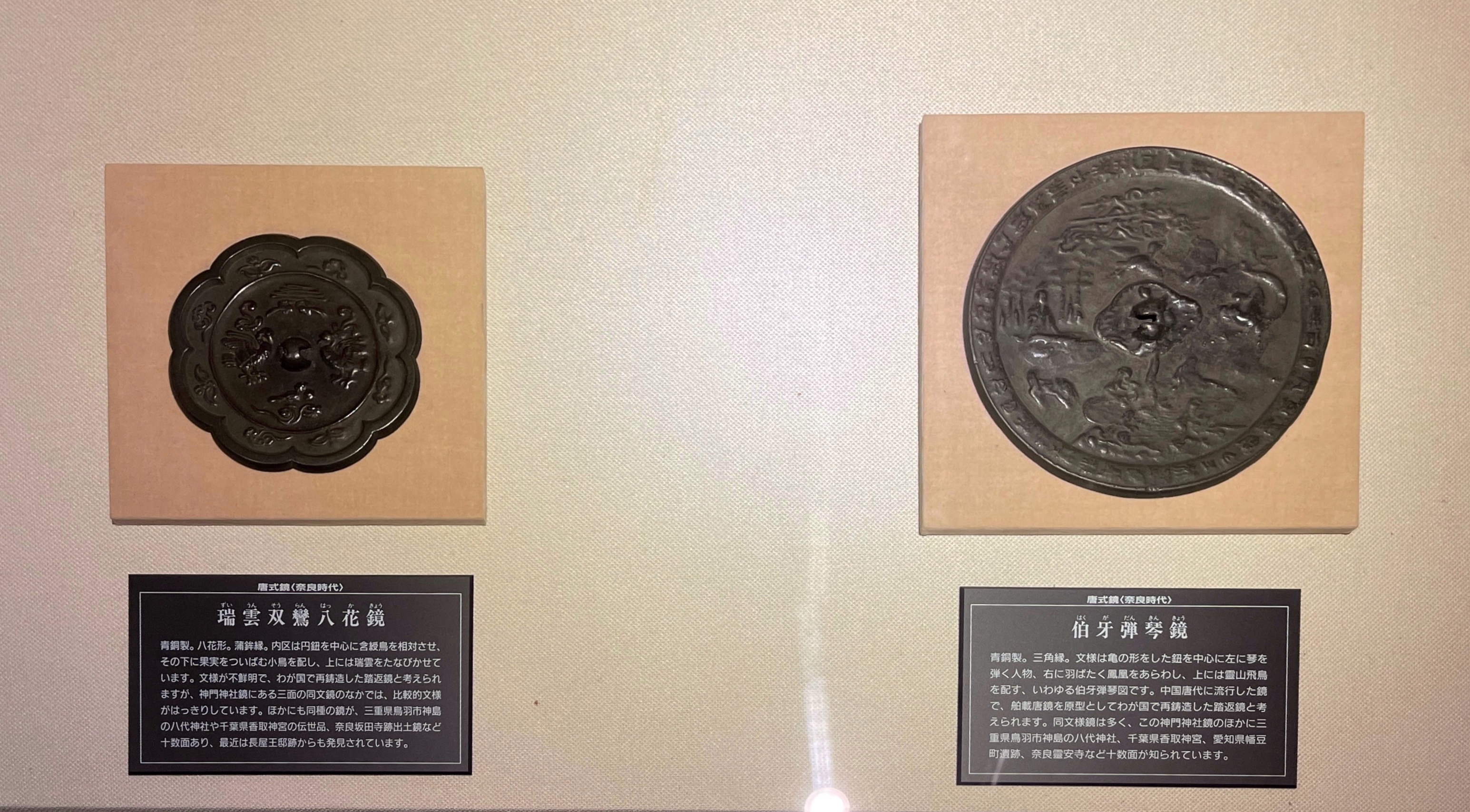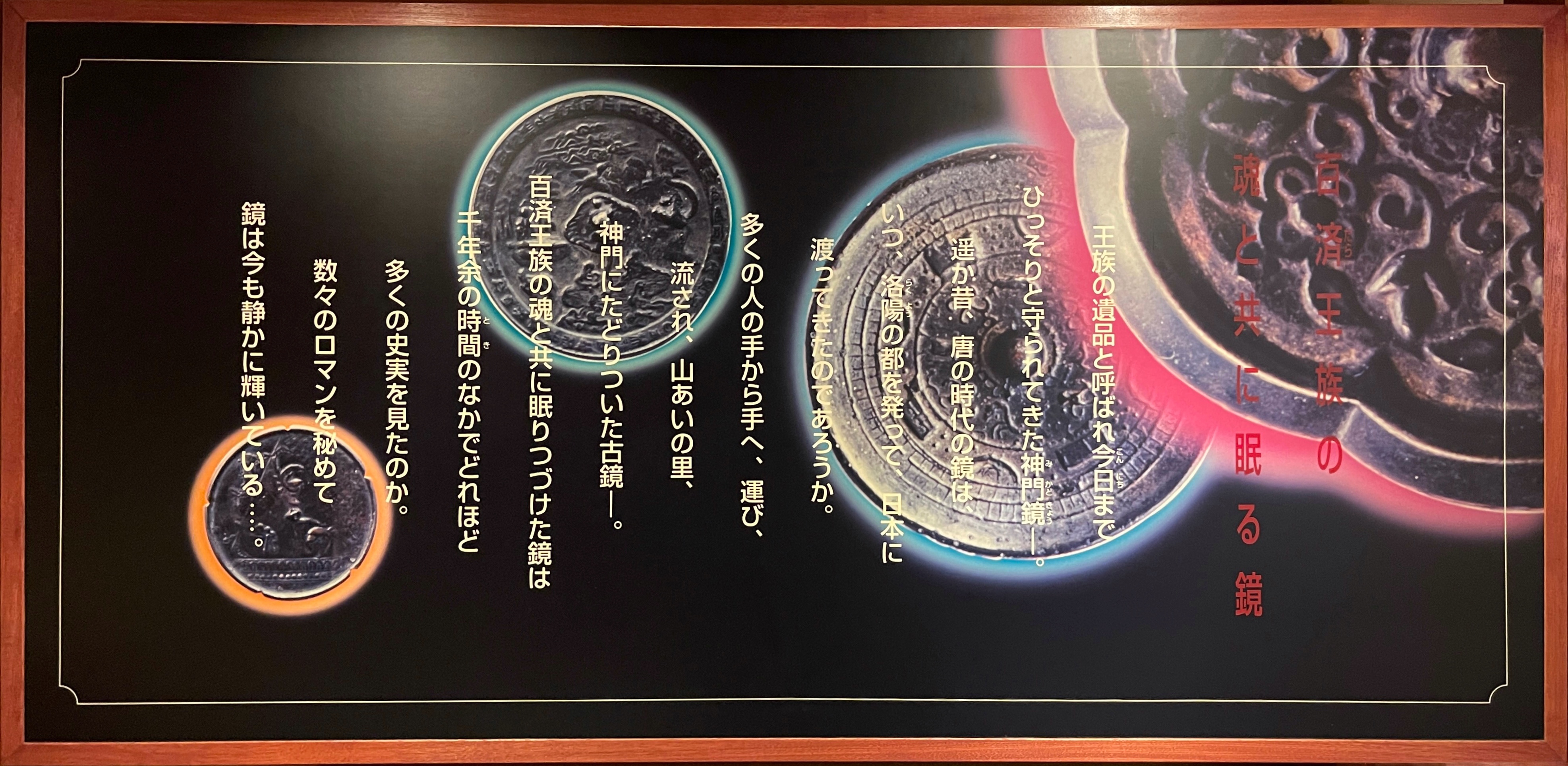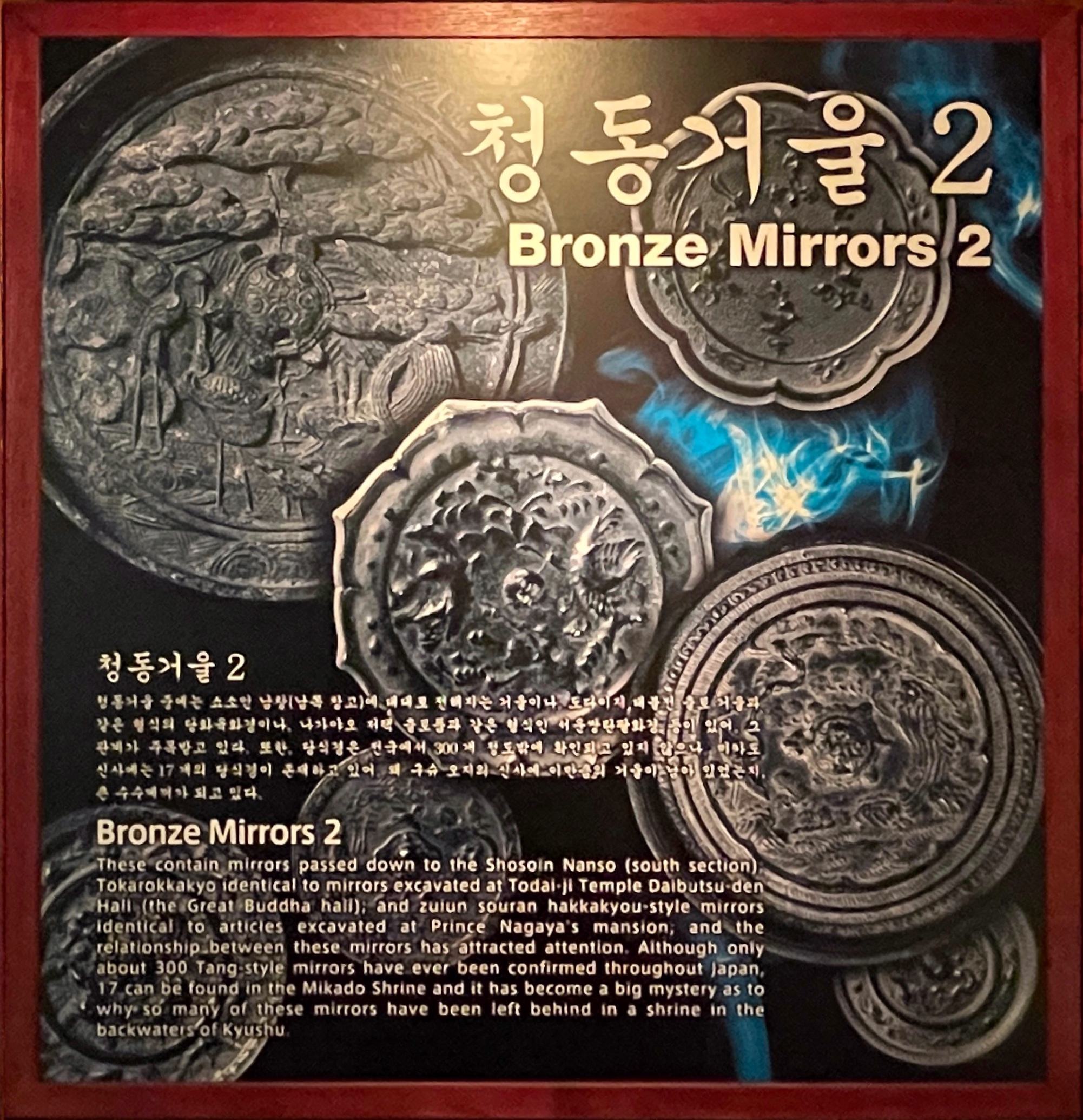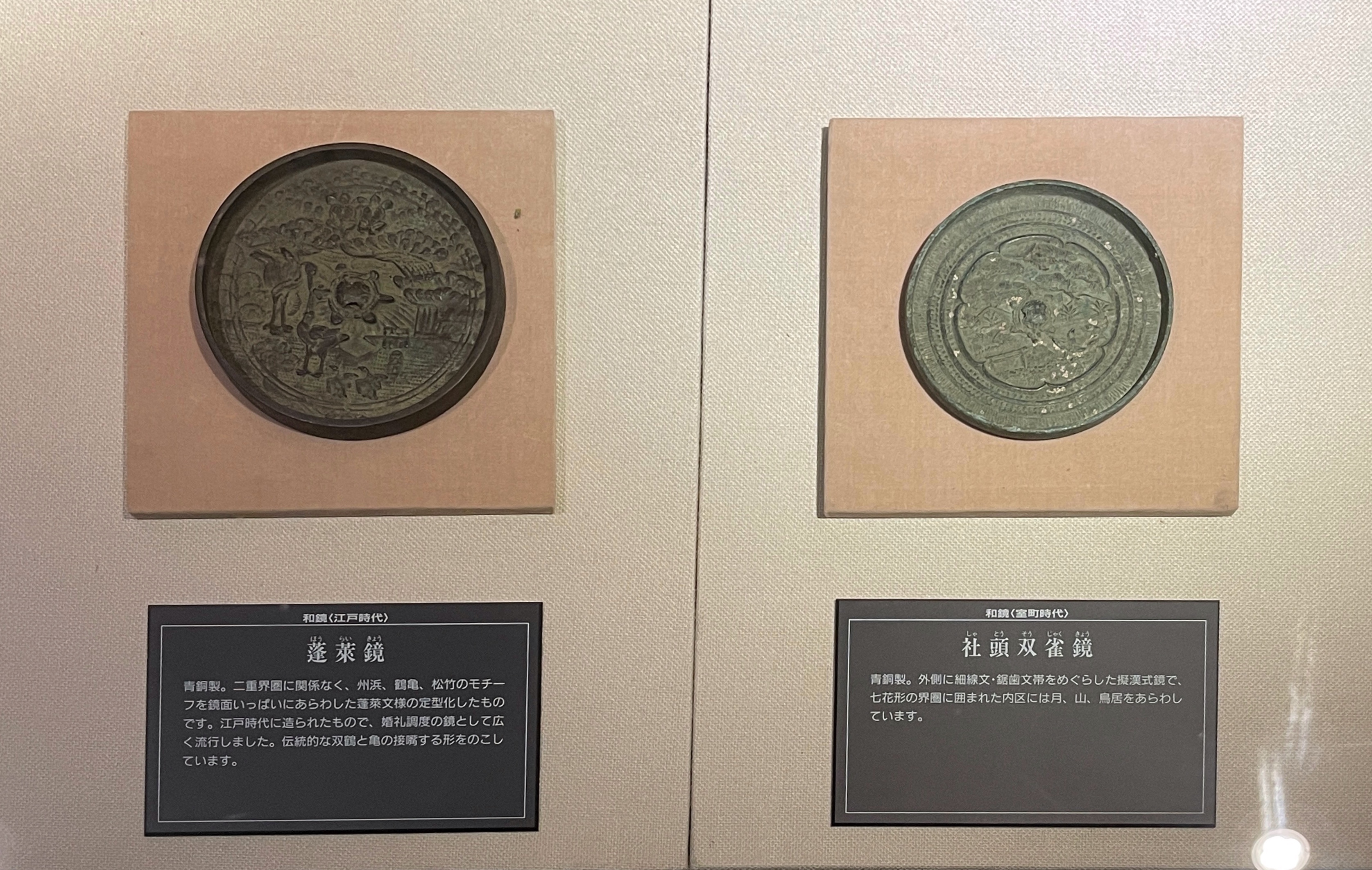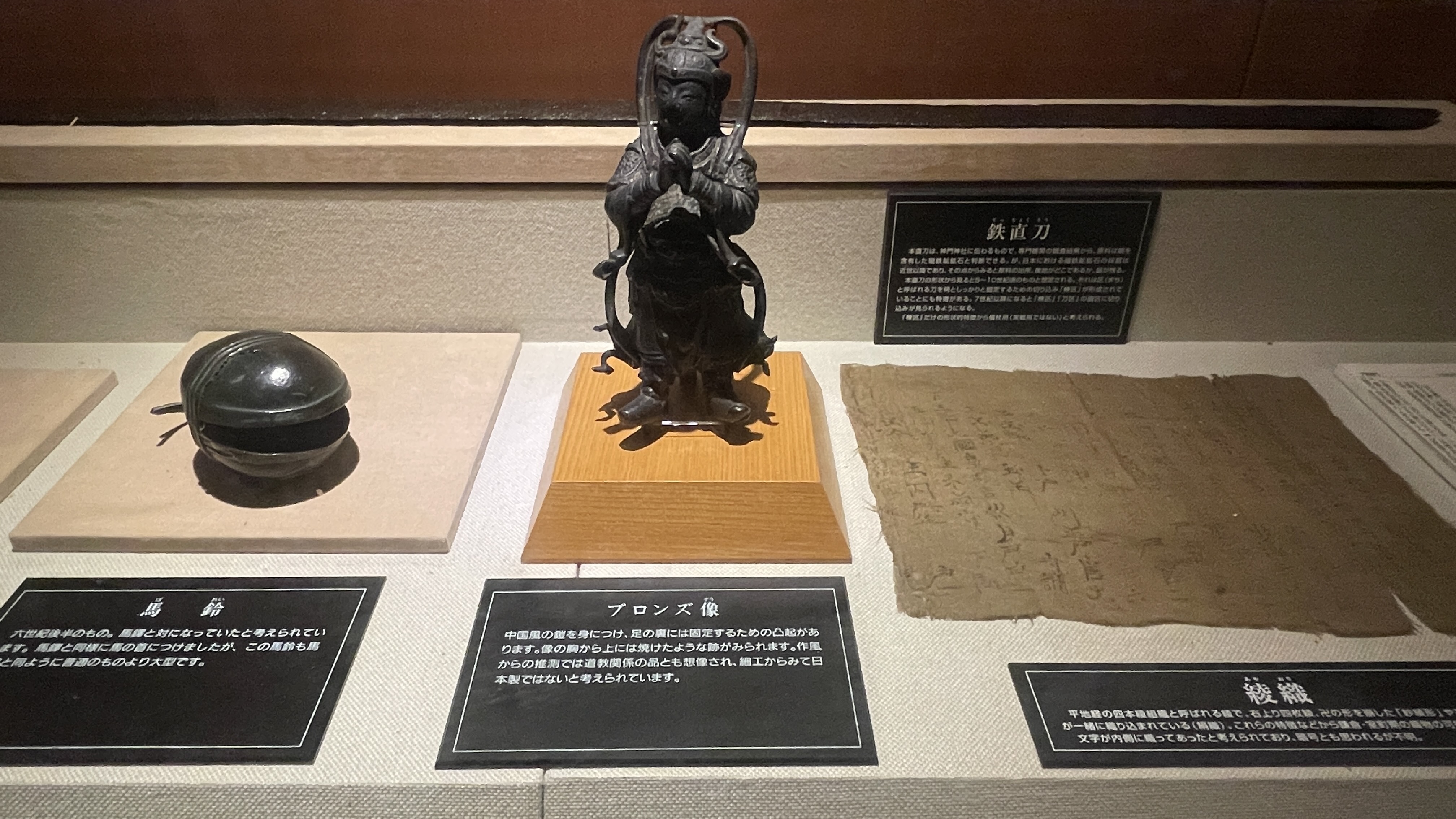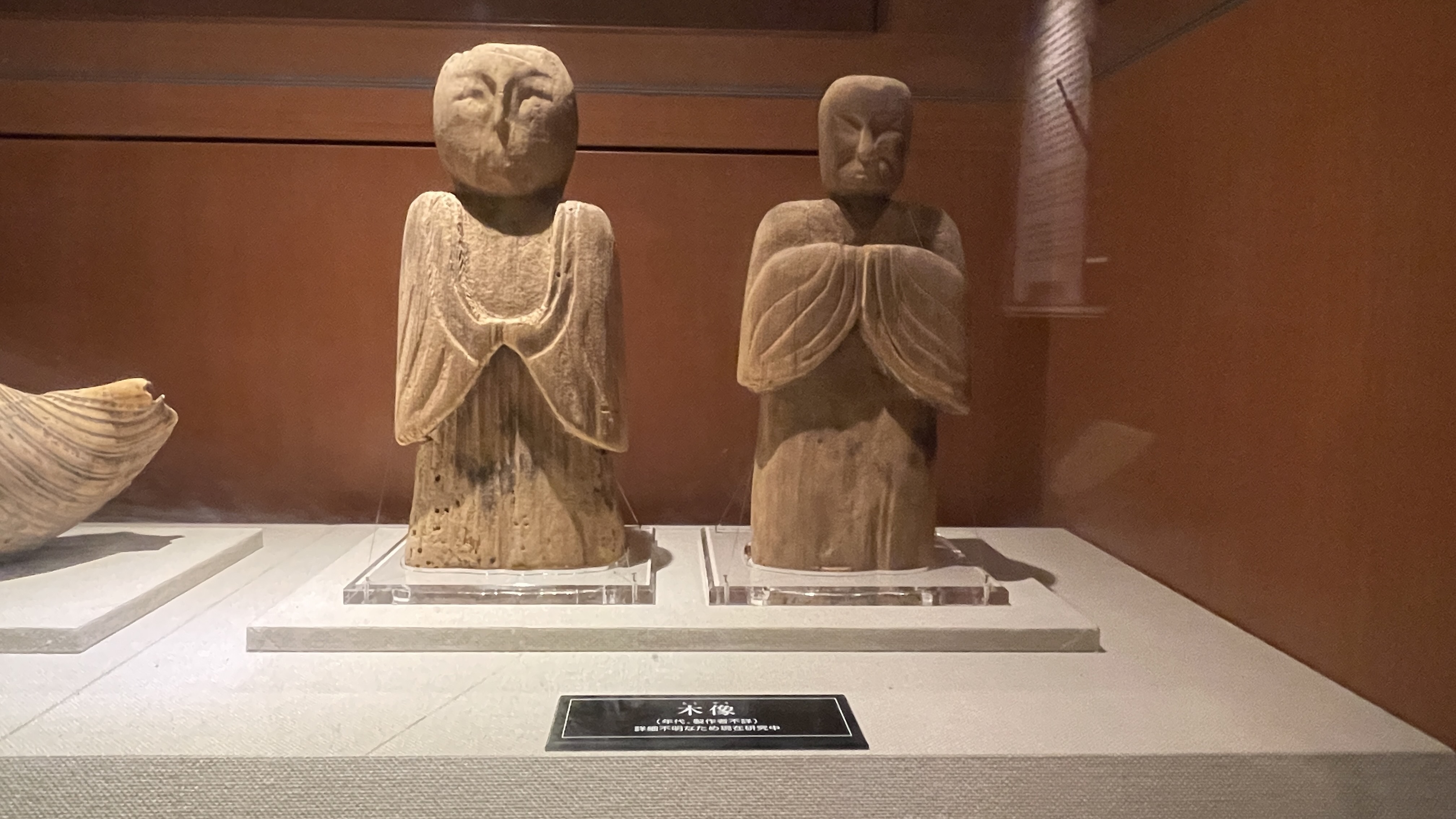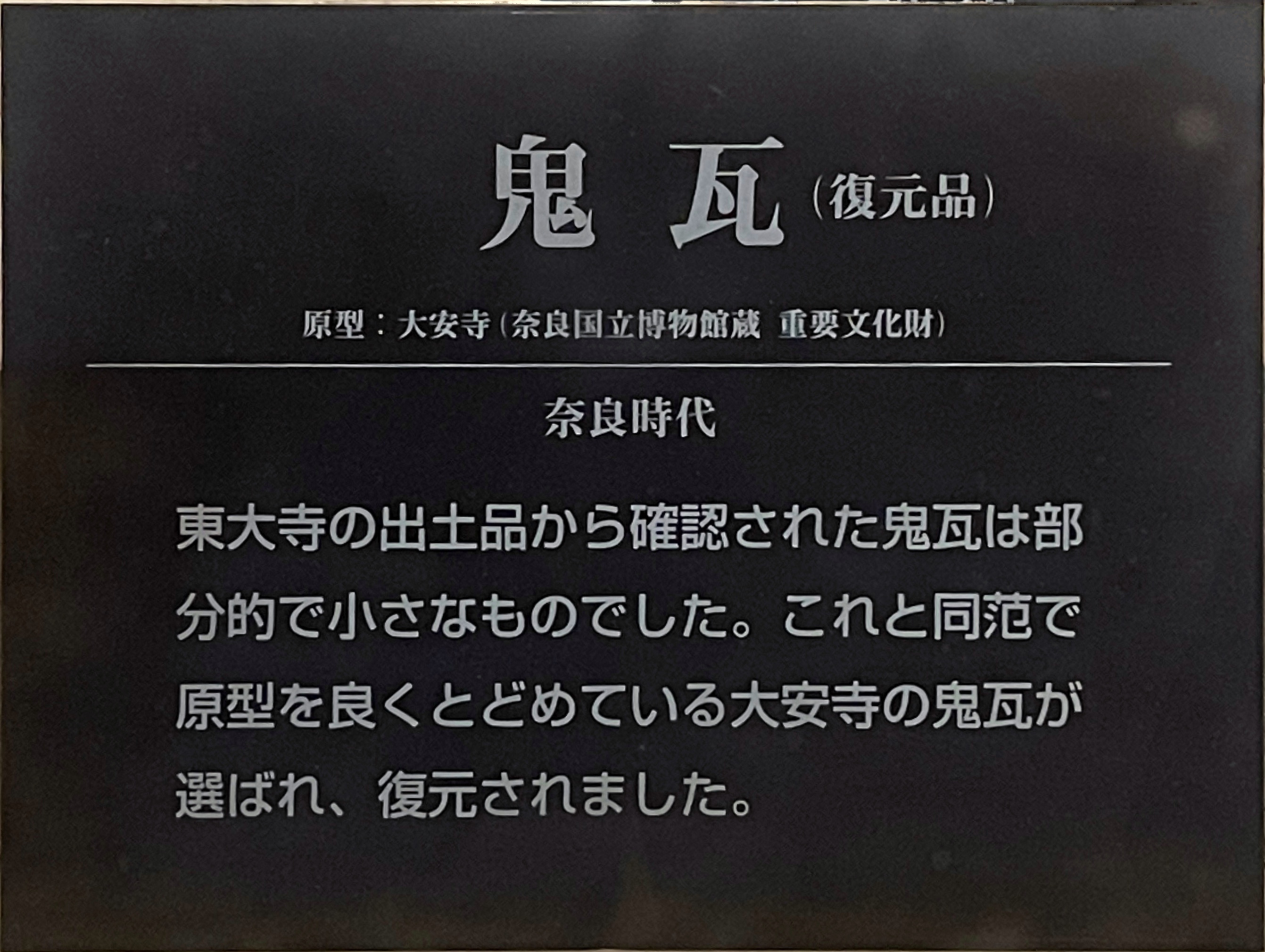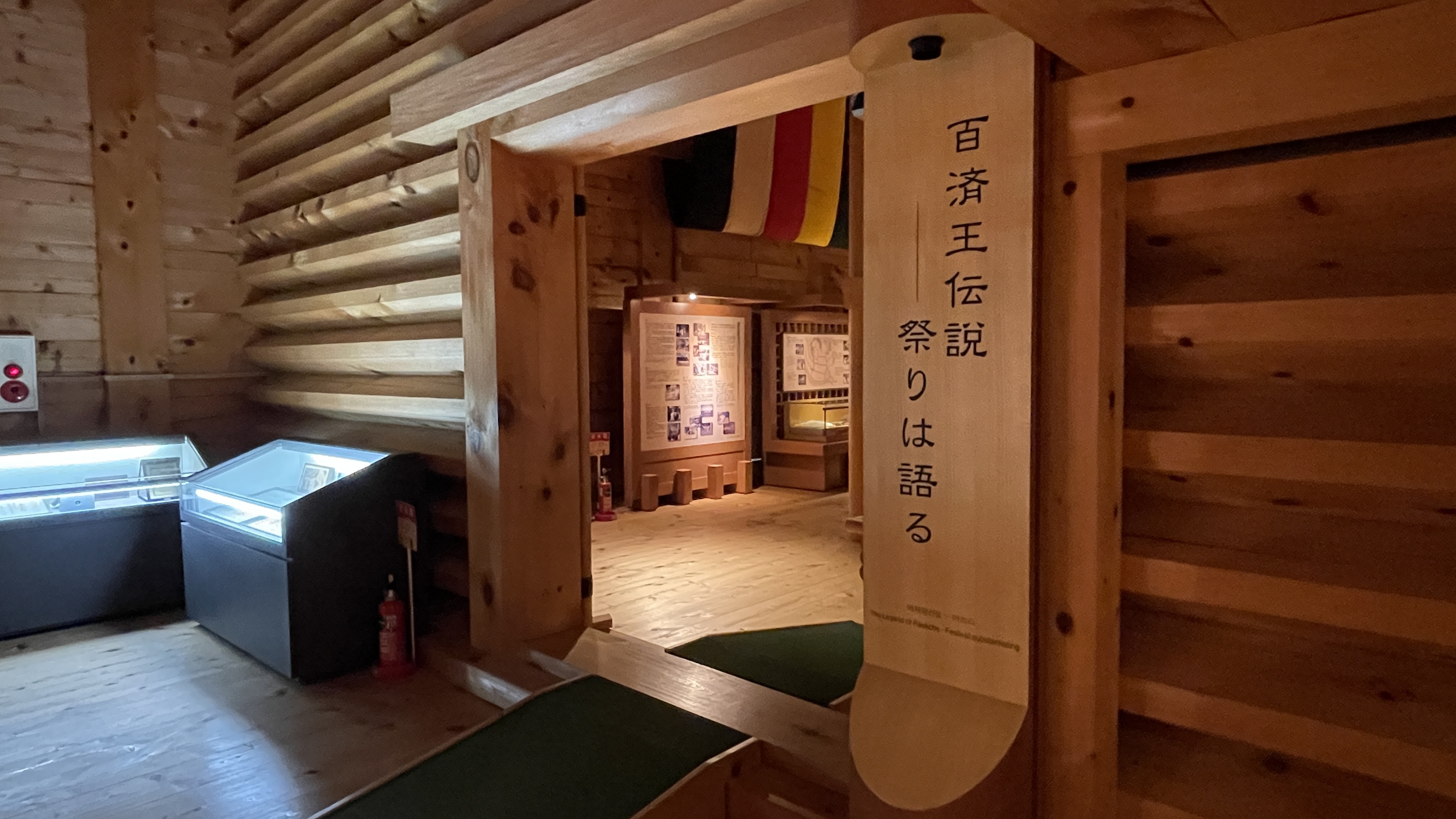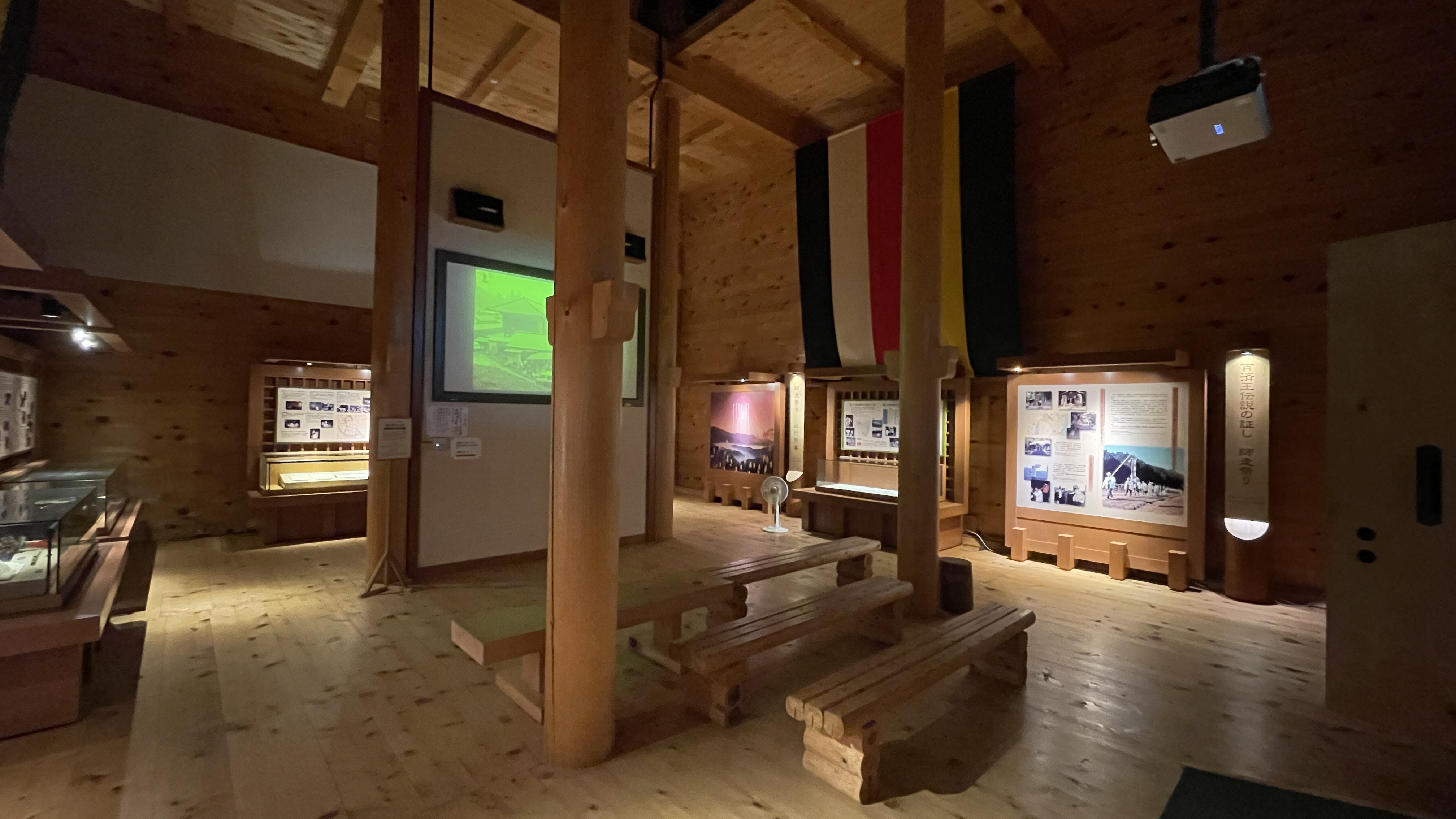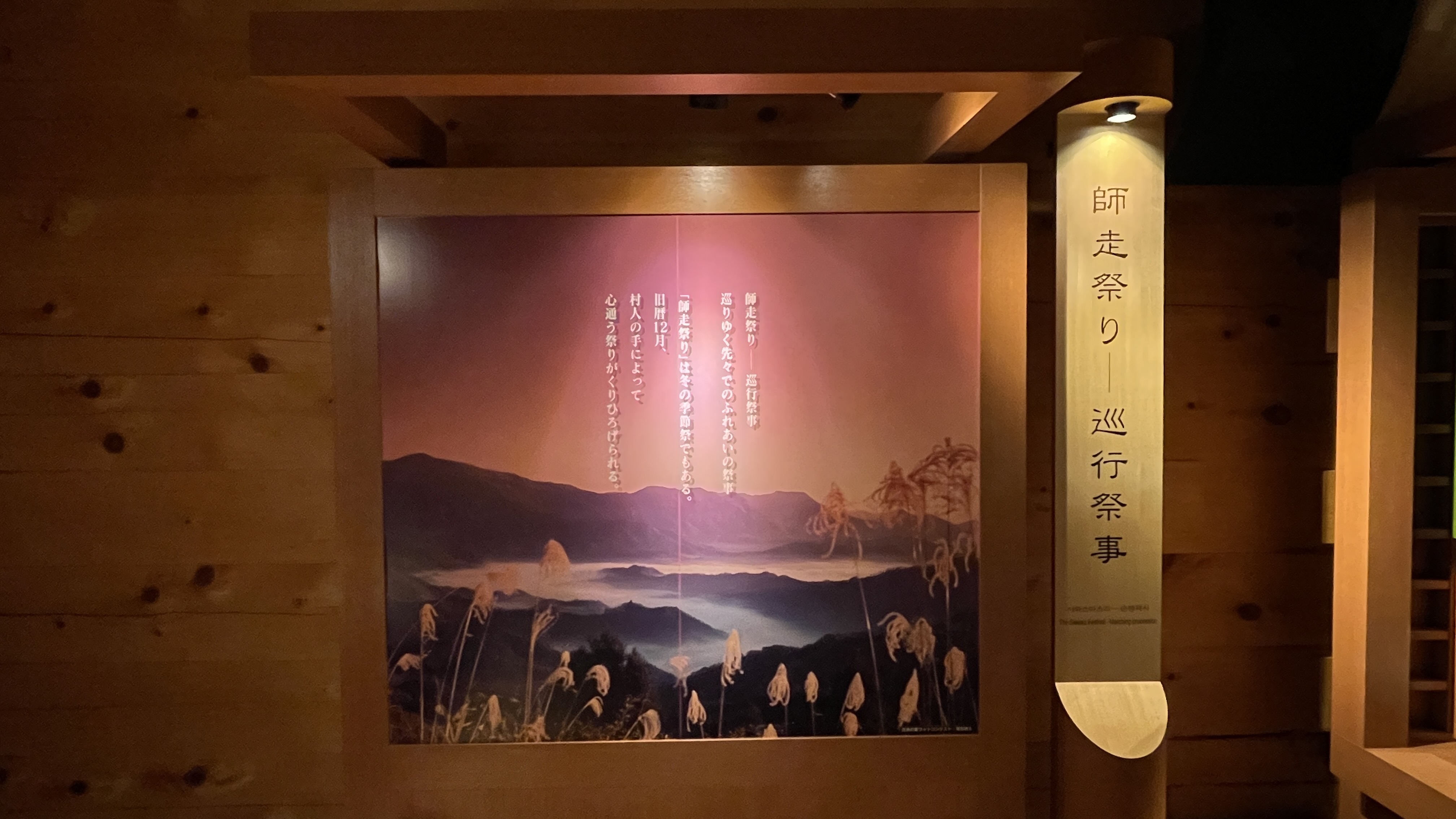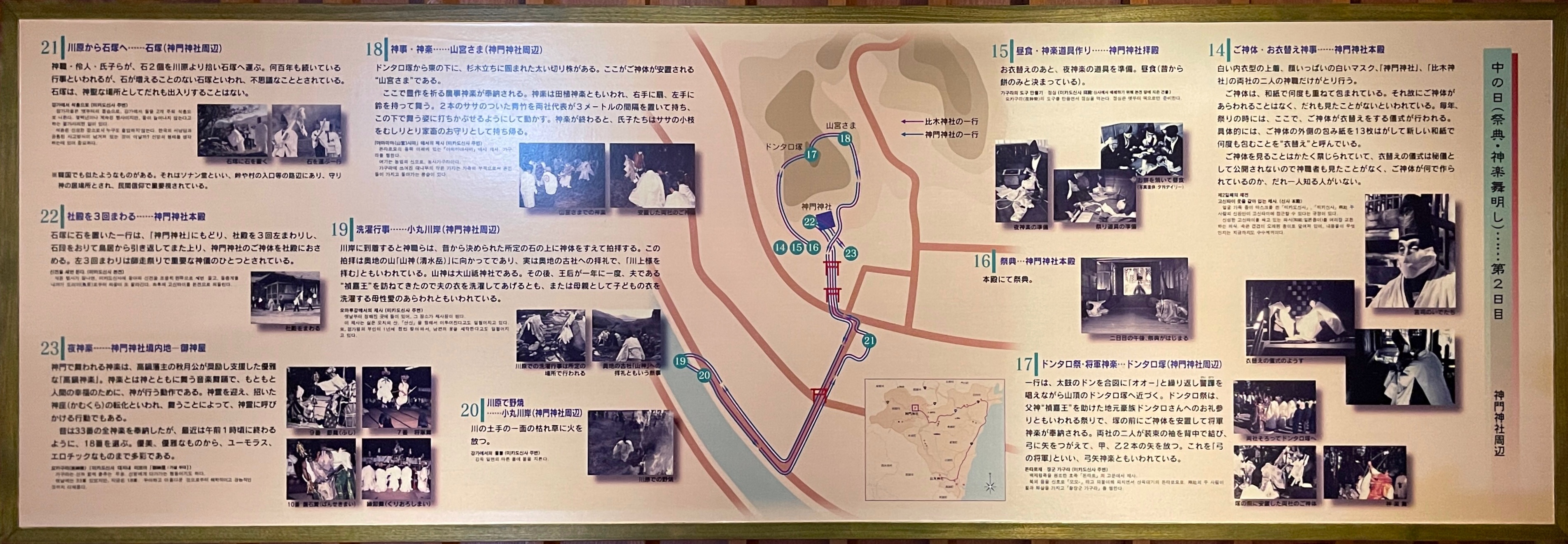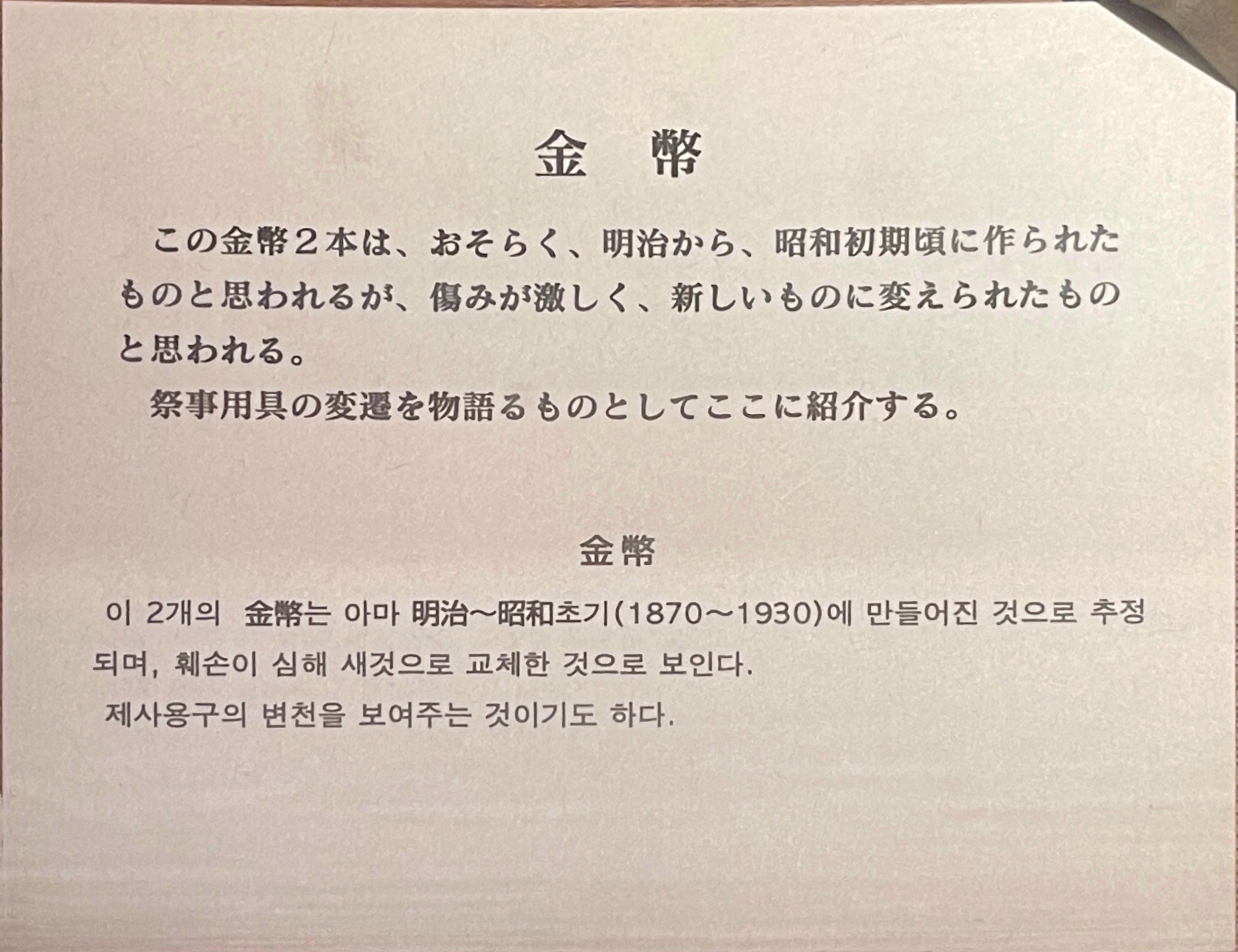memo12-45-05
MUSEUM
MIYAZAKI
Western Shosoin Warehouse
If you want to see the image at full size,
save it and see it.
(Confirmed with google chrome)
![]()
Visit date - 07/24/2021
Edit date - 09/04/2021

Among the ancient mirrors stored at Mikado Shrine, a valuable mirror called "Tokarokkakyo" was found.
This led to the construction of the Western Shosoin Warehouse, where Tokarokkakyo and other historical materials are stored and displayed.
The materials on display here are mainly weapons and mirrors that were stored at the Mikado Shrine.
These historical materials are related to the Baekje legend, and some of them have been protected for over 1000 years.
Western Shosoin Warehouse explains the legend of Baekje and the Teikaoh (Baekje royalty) worshipped at Mikado Shrine.
These explanations are lore, and not all of them have been proven to have actually happened.
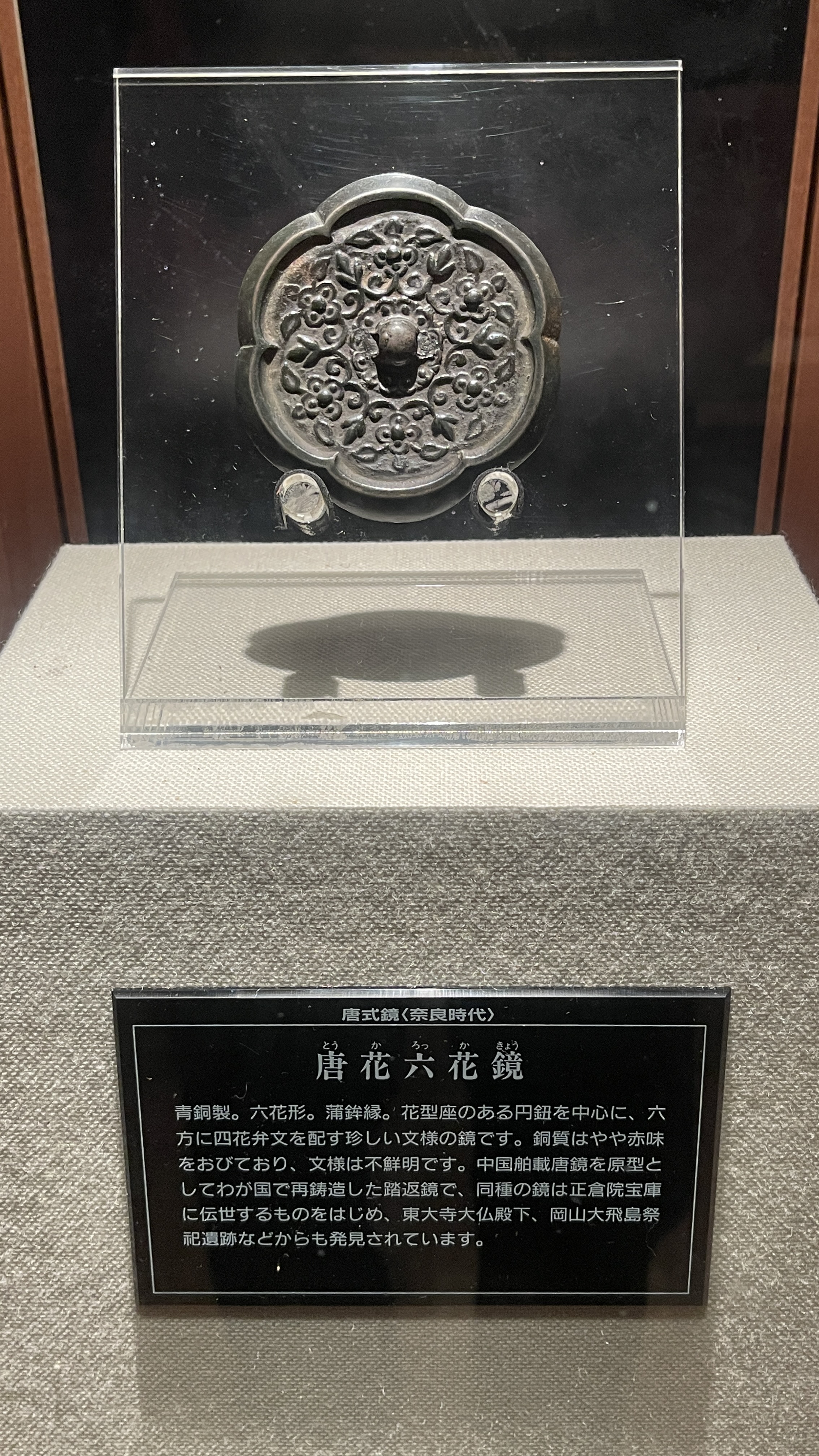
A view of the exhibition room at Western Shosoin Warehouse.
As soon as you enter the Western Shosoin Warehouse, you will see a panel.
This is a single panel explaining the legend of the fall of Baekje and the evacuation of Teikaoh (Baekje royalty) to Japan and their death in Nango village.
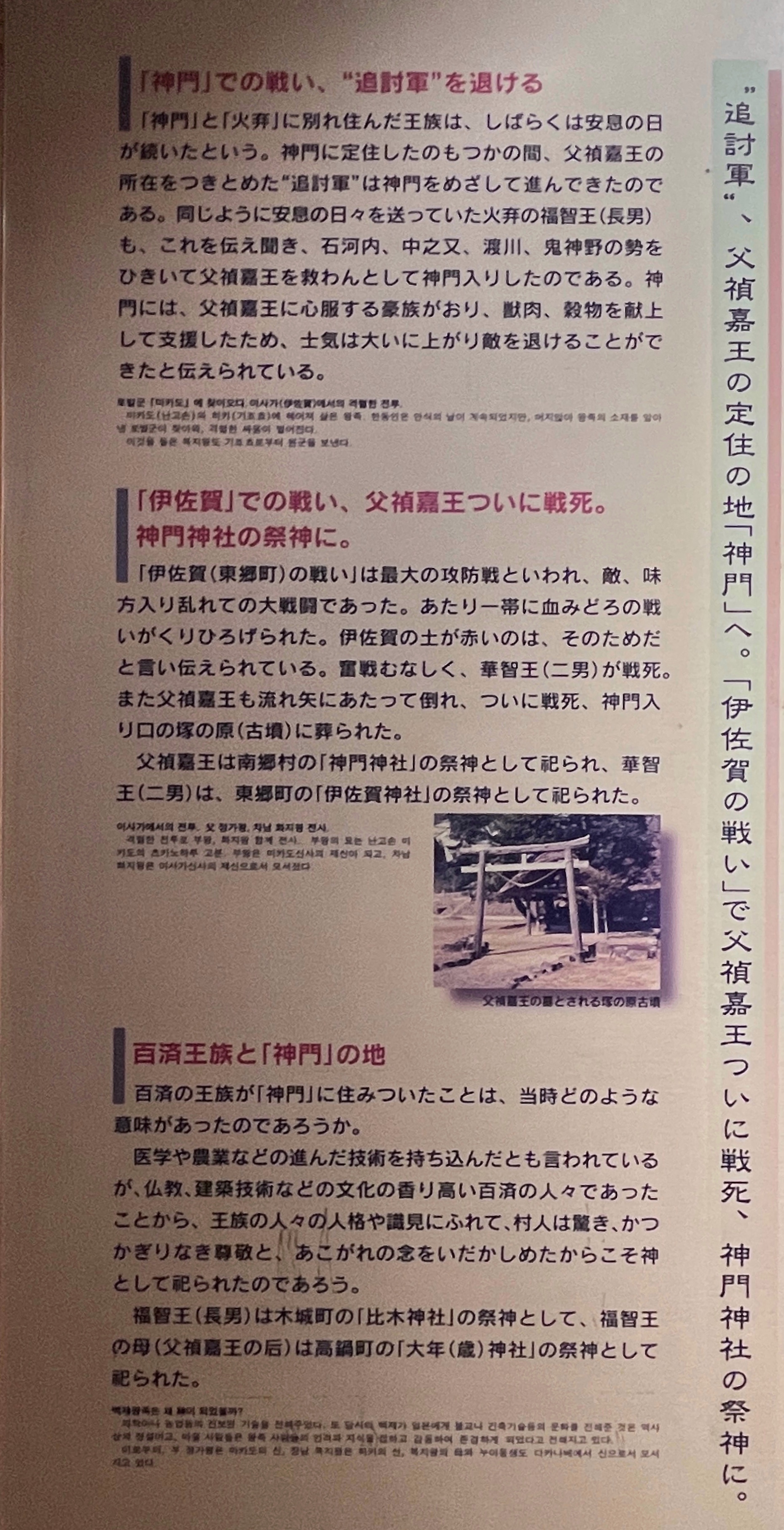


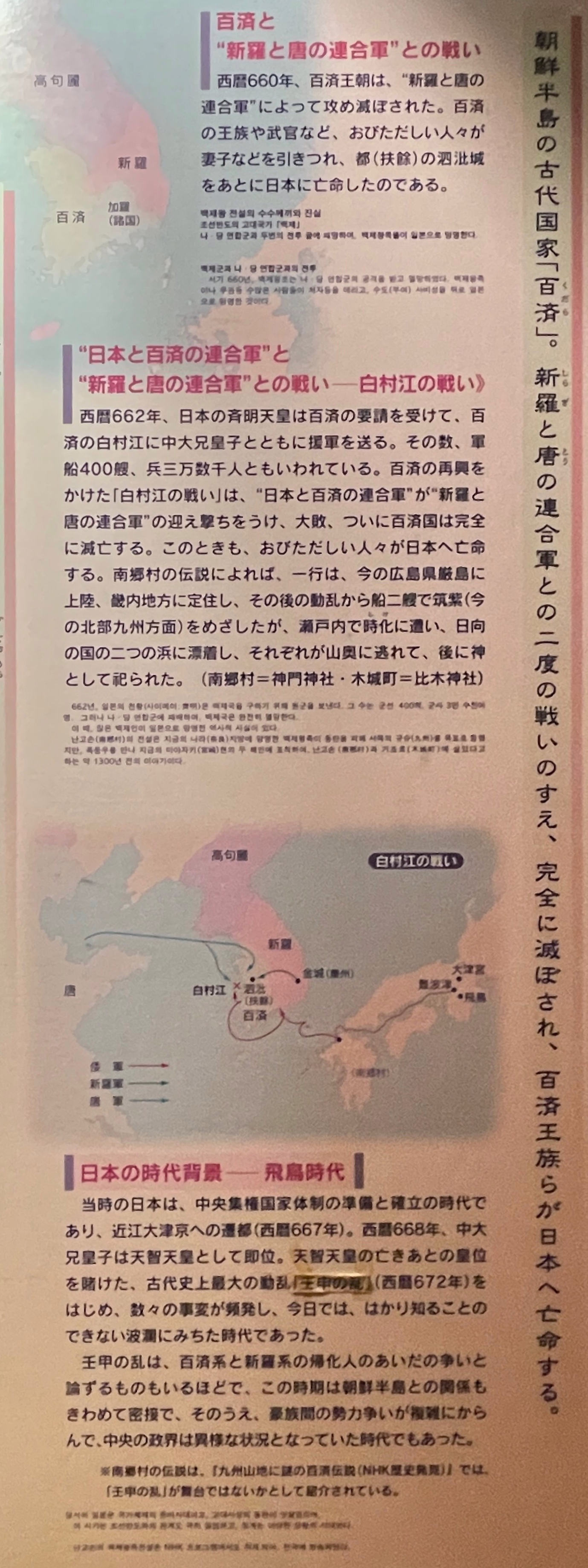
(Baekje goes to war with silla and Tang's allied forces.)
In 660 AD, Baekje was destroyed by the allied forces of silla and Tang.
After that, Baekje's royal family, military officers, and other people went into exile to Japan with their families.
Also, a small group of states called Kaya perished around this time. This Kaya had a Japanese branch office.
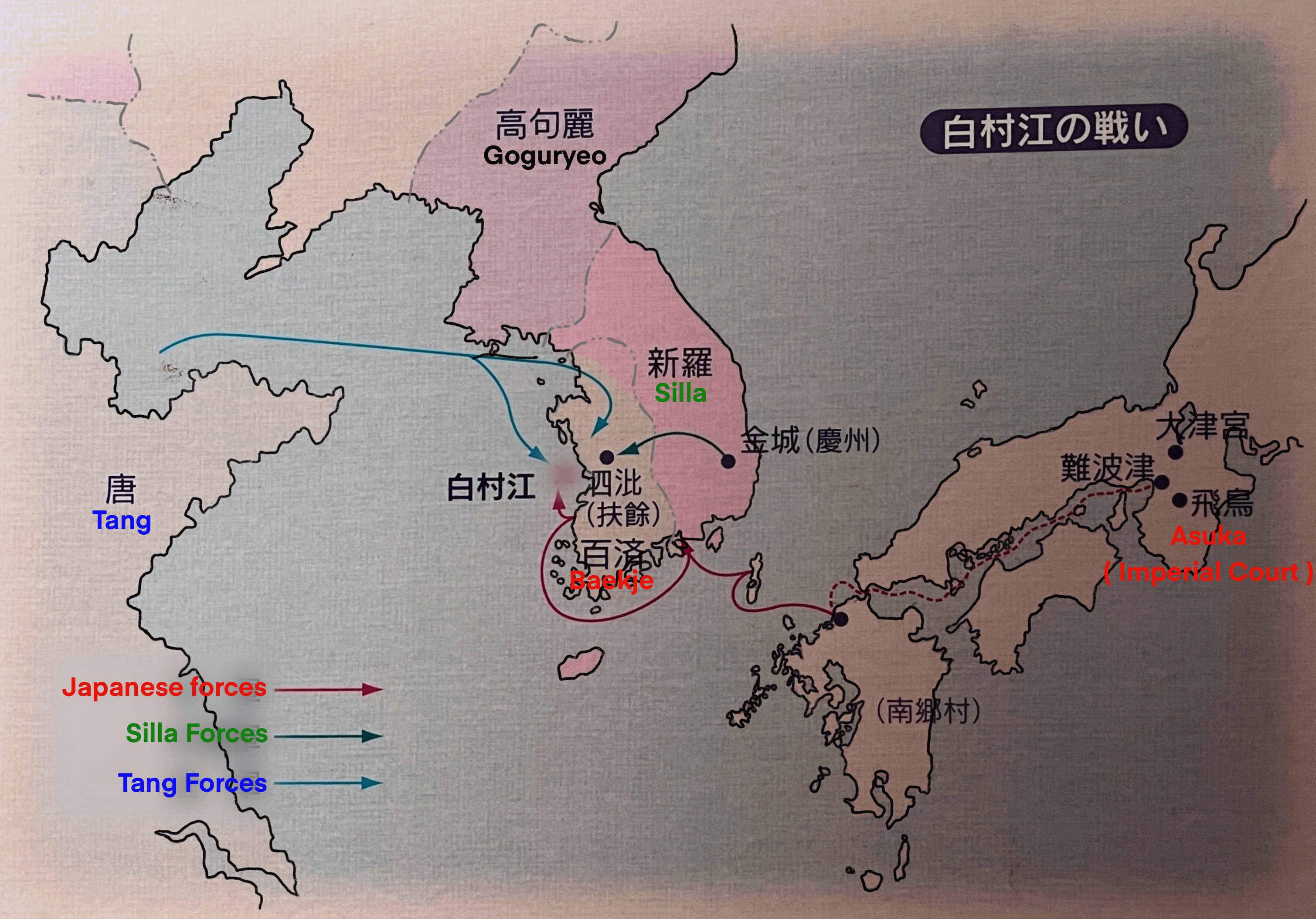
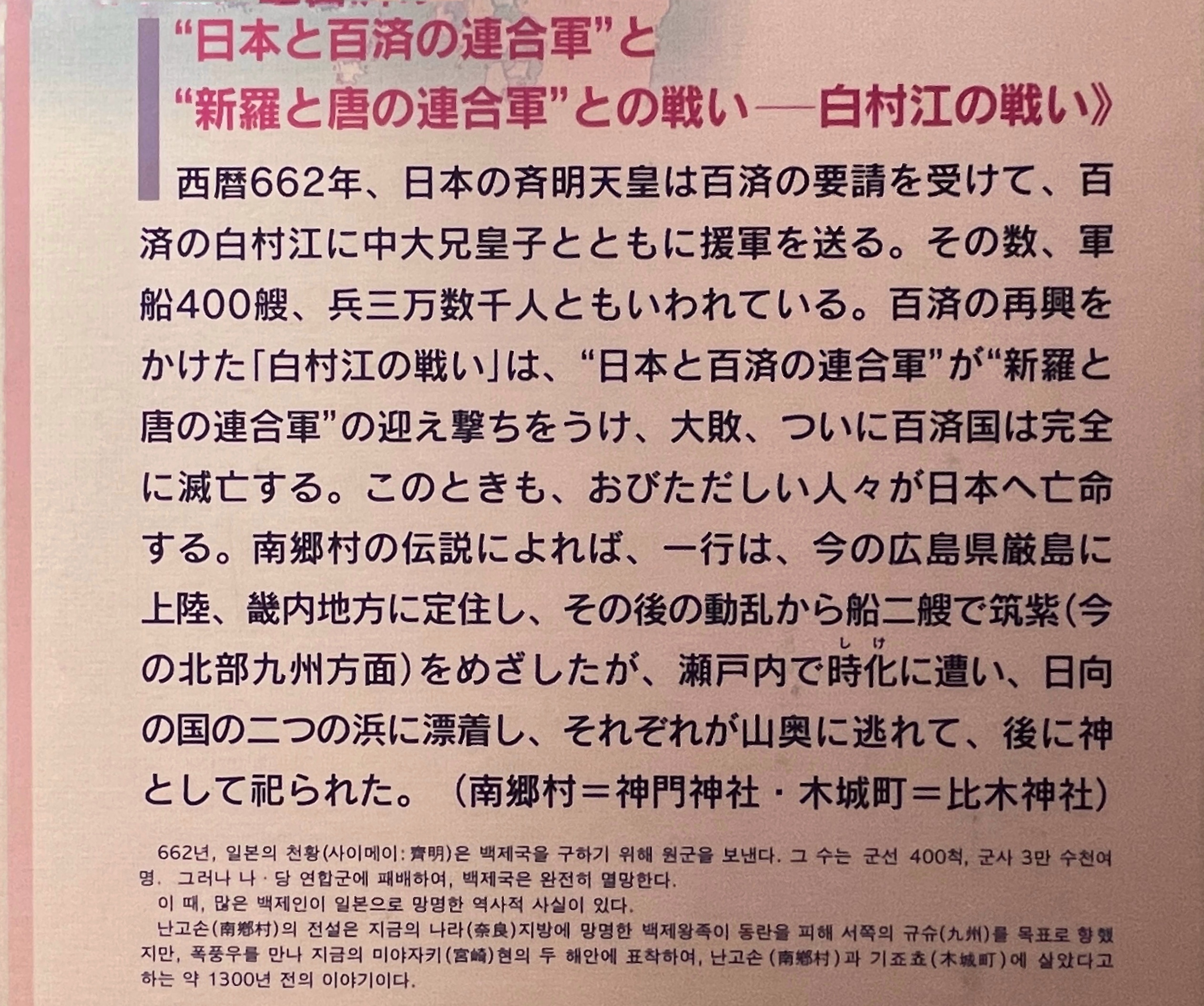
(Japanese and Baekje allied forces go to war with silla and Tang allied forces.)
In 662 A.D., Emperor Saimei (female emperor) of Japan sends Nakanoenooji (later Emperor Tenji) and his army to Baekgang at the request of Baekje.
This was a war for the revival of Baekje and was called the "Battle of Baekgang".
The war ended with a crushing defeat for the Japanese and Baekje allied forces and the complete destruction of Baekje, with many more people defecting to Japan.
(At the time, Japan was in the Asuka period.)
In Japan, a national political reform called "Taika no Kaishin" began in 645-650.
Until now, Japan was formed by the cooperation of powerful people in various parts of the country.
"Taika no Kaishin" aims to run the nation based on law, with the emperor at the center.
And this law is referenced to Tang's law.
Thus, the year 662, when Japan was defeated in the "Battle of Baekgang," was a time of national political reform.
And Japan had a civil war called "Jinshin no Ran" in 672.
"Jinshin no Ran" is said to be caused by the succession dispute of the emperor.
It is also said that the civil war was used by local authorities and naturalized citizens to expand their power.
For this reason, the central political scene in Japan during this period was said to be in an abnormal state.


When the Teikaohs (royalty) defected from Baekje to Japan, they gave up the idea of settling in the chaotic Japanese capital.
Teikaoh and his friends drifted to a beach called Kanegahama (Hyuga City, Miyazaki Prefecture) at the end of their boat trip.
It was decided by divination that Nango Village (now Misato Town) was the best place for the Teikaohs to settle.


Fukuchioh, the son of Teikaoh (royalty), was on a different ship from Teikaoh and his friends when they went into exile.
Fukuchioh and his friends drifted to a beach called Kaguchiura (Takanabe-cho, Miyazaki Prefecture) at the end of their boat trip.
It was decided by divination that the best place for the Fukuchiohs to settle would be in what is now Kijho town.

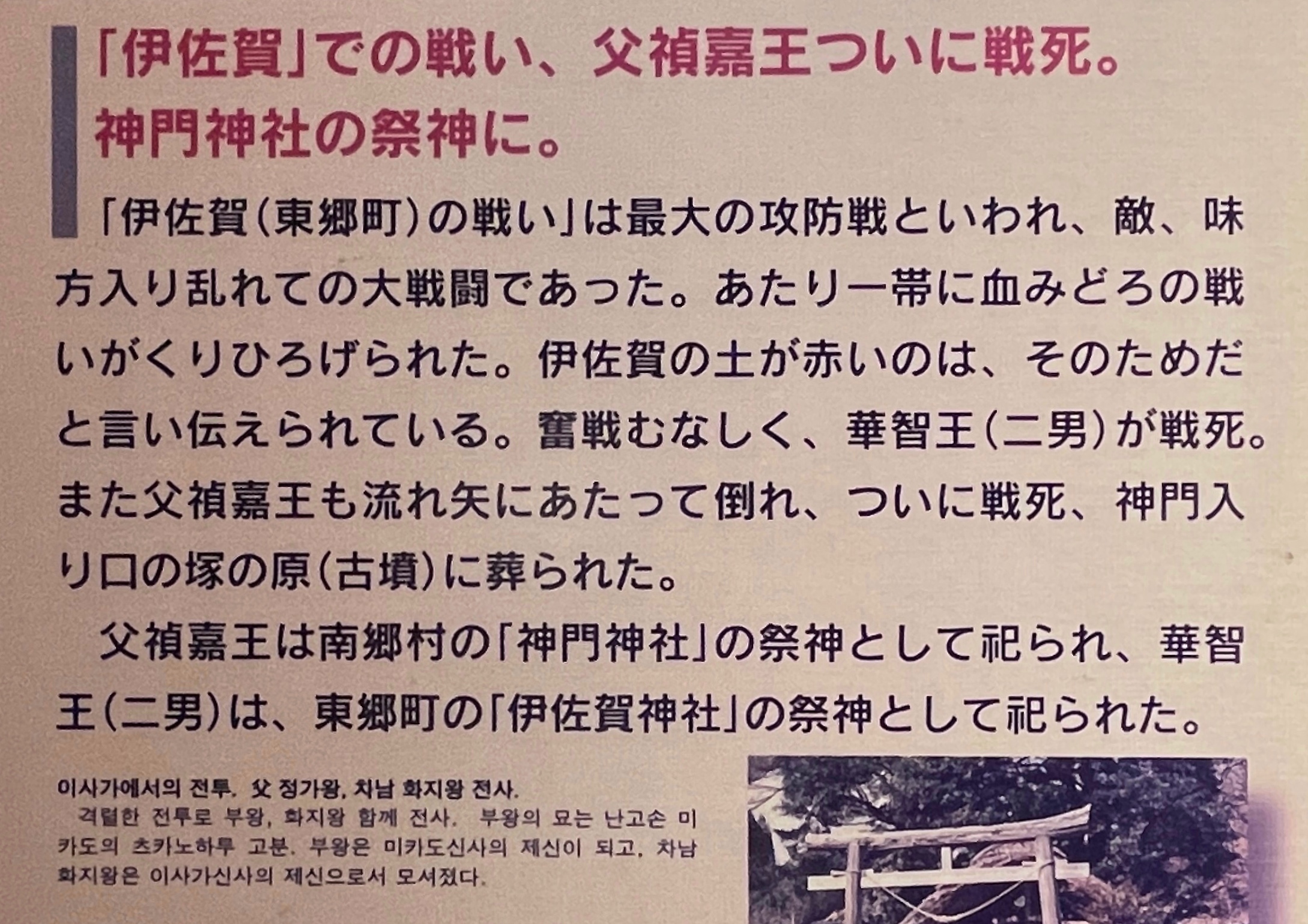
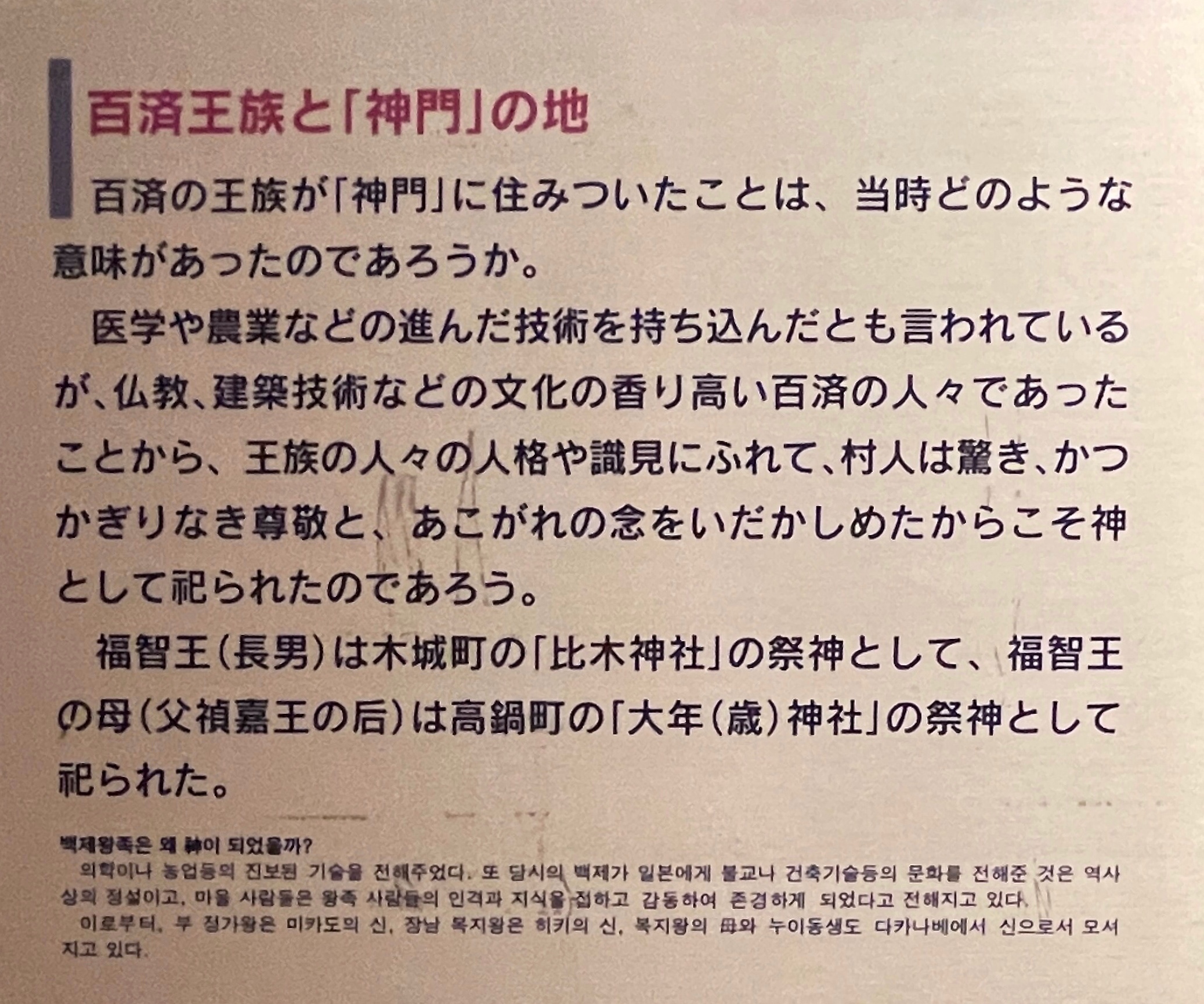
The Baekje royalty, who began to live separately in Nango village and Kijho town, continued to lead a stable life for a while.
Later, however, Teikaoh and his men were killed in battle by the pursuing army that was looking for Teikaoh.
After the war was over, Teikaoh was enshrined in Mikado Shrine and Fukuchioh in Hiki Shrine.
This means that Teikaoh and Fukuchioh were respected and supported by the local people.



The entrance to the exhibition room is next to a panel explaining the relationship between Teikaoh (Baekje royalty) and Nango village.
This exhibition room displays weapons and mirrors that were stored at Mikado Shrine.
The following is an introduction to the exhibition room.


In April 1998, a survey of the buildings of Mikado Shrine revealed 1006 spears.
Some of the spears are displayed here.
(Han style mirror)
In prehistoric times, mirrors were made by polishing the surface of metal flat and making it shine.
Mirrors in Japan during the Yayoi period (up to the middle of the 3rd century) were imported from Han (China).
Later, the Japanese created mirrors that imitated the Han style mirrors.
(Tang style mirror)
There were 17 Tang style mirrors found at Mikado Shrine.
Some of them are very valuable.
The map above shows the discovery of Tang style mirrors throughout Japan.
(Tang Culture and Mirrors)
In the Nara period (8th century), Japan was in the midst of a national effort to absorb Tang culture.
This led to the importation of many gorgeous Tang-style mirrors into Japan.
Tang-style mirrors, which became popular in Japan with the arrival of Buddhism, were actively used in temples throughout Japan.
Later, domestically produced mirrors imitating the Tang style mirrors were mass-produced in Japan.
Tang-style mirrors eventually gave way to mirrors with a uniquely Japanese feel, and Japanese mirrors with elegant patterns were born.
These mirrors are said to be Mikado mirrors and are said to be relics of the Baekje royal family.
(Japanese style mirror)
In the late Heian period (around the 12th century), Japanese mirrors changed from Tang style mirrors to Japanese style mirrors.
The patterns on the mirrors changed from fanciful birds to cranes and sparrows.
Chinese flower and arabesque patterns have been replaced by pine and yamabuki.



These are pictures of the space in the center of the building.
This is Onigawaqa.
Related spots
![]()
This exhibition room is located at the far end of the building.
This exhibit explains the Shiwasu Festival in Nango Village.
Shiwasu Festival is said to be a festival that has been going on for 1300 years.
The Shiwasu festival is based on the legend of Teikaoh and Fukuchioh who defected from Baekje.
---------+---------+---------+---------+---------+---------
Western Shosoin Warehouse
62-1 Nangomikado,Misato-cho,Miyazaki-ken
883-0306 Japan
Home Page : https://www.town.miyazaki-misato.lg.jp/kiji003412/index.html
TEL : +81-982‐59‐0556
#Miyazaki
#Saito Kofun Festival
#Japan
#Japanese
#Travel
#Sightseeing
#tourism
#garden
#Museums
#scenery
#Landscape
#shrine
#temple
#church
#castle
#HighCulture
#animism
#日本
#観光
#旅行
#日本庭園
#博物館
#神社
#寺
#景観
#城
#教会
#ハイカルチャー
#アミニズム
#Baekje
#西の正倉院
#正倉院
#神門神社
#比木神社
#唐花六花鏡
#百済
#禎嘉王
#福智王
#華智王
#金ヶ浜
#蚊口浦
#扶餘
#白村江
#南郷村
#木城町
#壬申の乱
#神門
#火弃
#漢式鏡
#唐式鏡
#三十六歌仙絵
#師走祭
#
#
#
#

